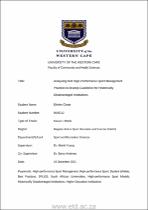| dc.description.abstract | High-performance sport is characterised by the effective amalgamation and synergy of elements, including financial and managerial support, coaching, sport sciences and sports medicine support, talent identification and athlete pathways, training facilities and equipment, and competitions. Universities have increasingly become hubs for high-performance sports services, used by students and non-students alike. According to Dr Ralph Richards, a senior research consultant for Sport Australia, most university students are in their late teens to early 20s, which is also a critical demographic for elite sports performance. Universities can and do have a substantial impact on the sports sector, particularly in supporting and developing elite student-athletes through quality facilities and infrastructure, supportive programming, competitive opportunities, and sports bursaries or scholarships. In recent years, the high-performance sport has firmly established itself as a modern industry at some top- performing South African Universities. Since the Varsity Cup and Varsity Sport’s inception, South African Institutions have invested more in developing the sport to win competitions. However, many institutions, especially Historically Disadvantaged Institutions, do not establish athletic performance pathways. The study aimed to create guidelines for the best high-performance sport management practices and analysed successful international and local systems. The Spliss Model (a theoretical model of 9 pillars of sport policy factors influencing international success) provided the theoretical framework for this study. This study used a purely qualitative approach informed by an extensive literature review. This was followed by face-to-face semi-structured interviews with the high-performance sports directors and directors of sport at Universities and sports organisations in South Africa who currently have high-performance sports units. The data were transcribed verbatim and analysed through the lens of the SPLSS model. A thematic analysis was conducted to identify the best practices for high-performance sport at Historically Disadvantaged Institutions. The key findings showed that the best practices for high-performance sports systems included proper governance, appropriate funding, training facilities, quality coaching, sport science support services, academic support services and opportunities to compete. Ethics considerations were observed where the anonymity of the participants was upheld by way of using pseudonyms after permission from them were obtained. Permission to conduct the study was obtained from the University of the Western Cape Humanities and Social Sciences Research Ethics Committee. | en_US |

